Design
Measuring 4,54 m (178 inches) long, 1,89 m (74 inches) wide and 1,64 m (64 inches) tall, the all-electric crossover features the brand's familiar three-claw light signature at the front and rear, with an enlarged logo on the closed grille and smaller headlights nestled between the hood and the frameless grille.
The E-3008 comes standard with LED headlamps that use the brand's Pixel LED light technology on all versions, which is a sophisticated way of saying that they're adaptive.

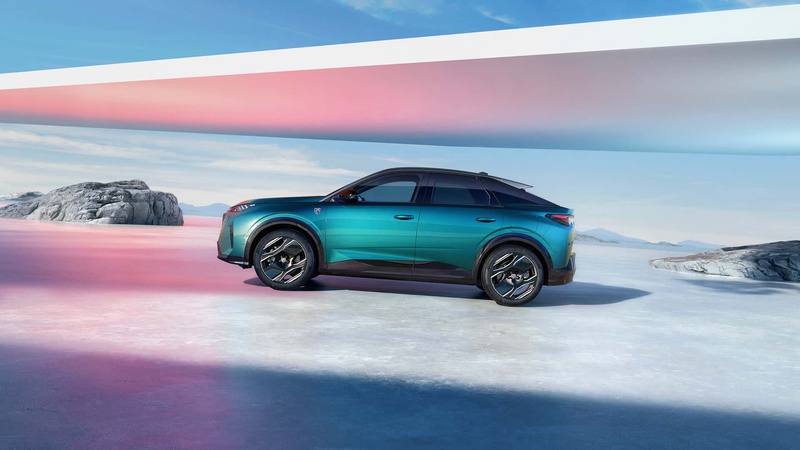

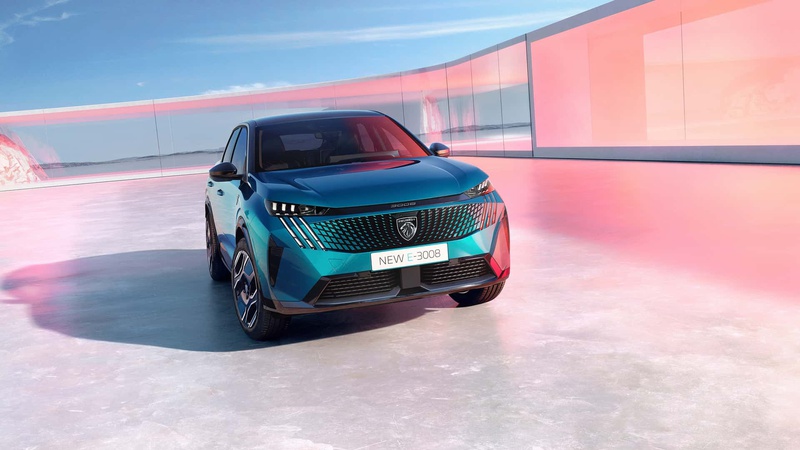
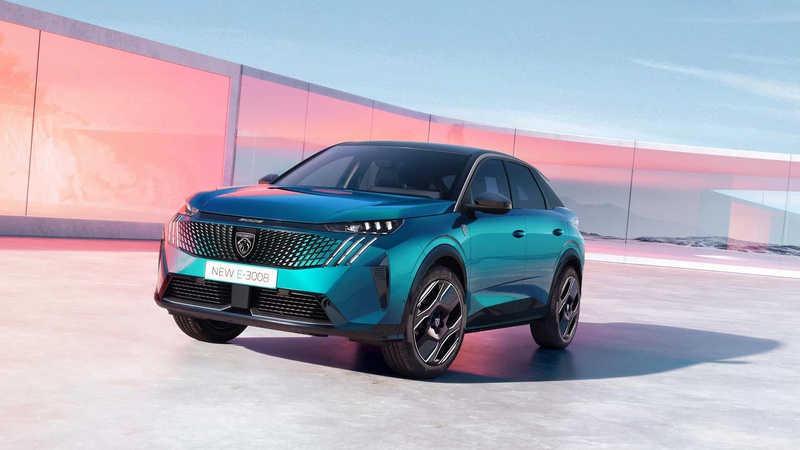

Peugeot E-3008
Six color options are available at launch, with a color-shifting Obsession Blue being the highlight of the range, changing from blue to green depending on light and viewing angle. The other colors are:
- Ingaro Blue
- Okenite White
- Pearl Black
- Artense Gray
- Titanium Gray
Interior
Inside, the main talking point of the new Peugeot E-3008 is the massive 21-inch curved widescreen i-Cockpit display that sits atop the dashboard and acts as both a digital instrument cluster and infotainment screen.
Not all versions benefit from this single slab of screen real estate, however, with the Allure trim offering a slightly different setup that's made up of two 10-inch screens integrated into a single mount.

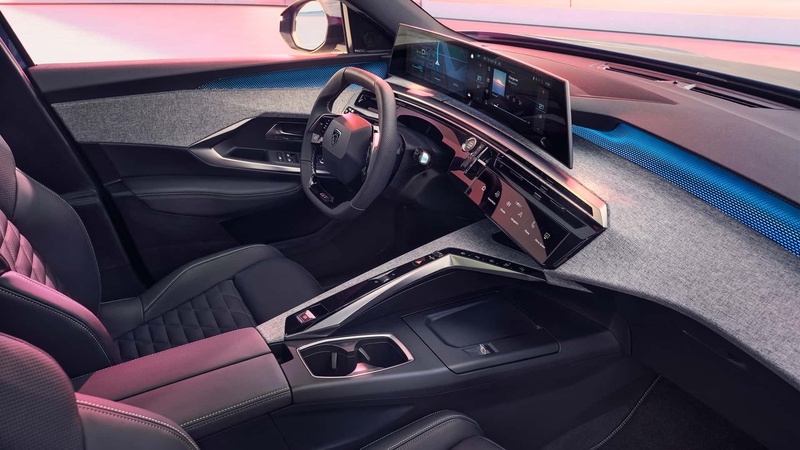

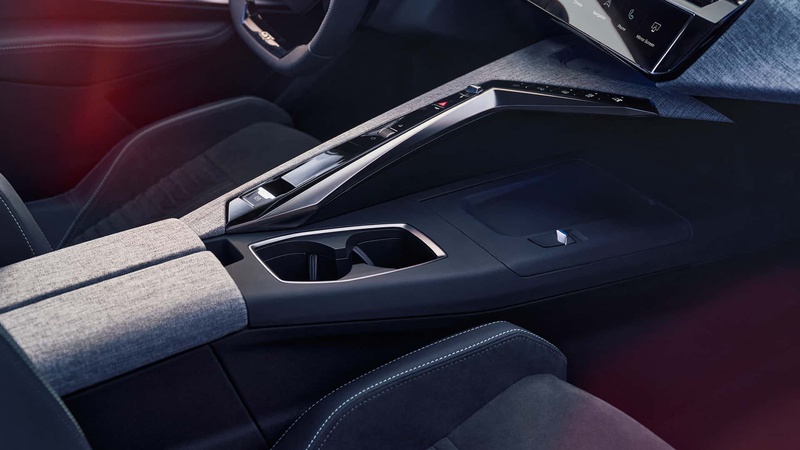
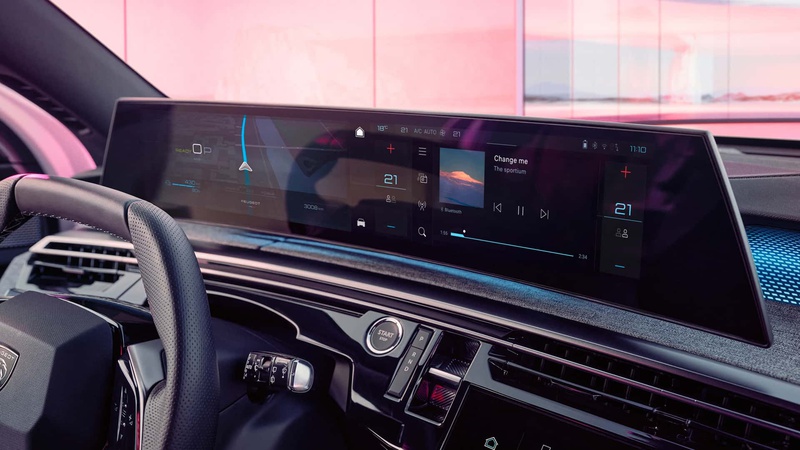
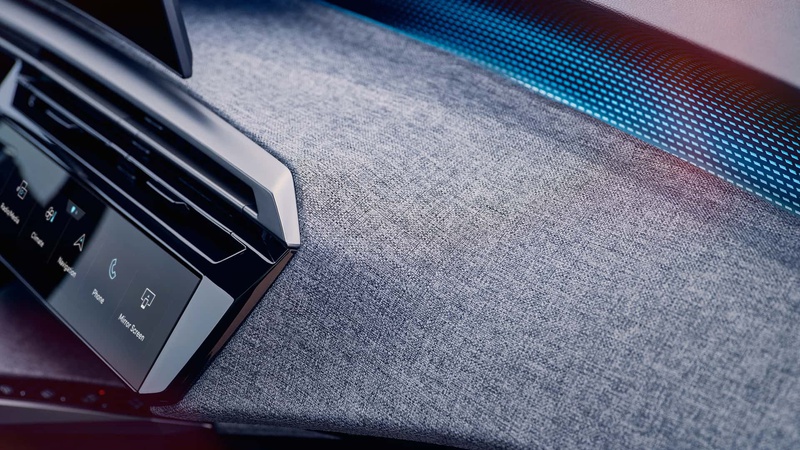
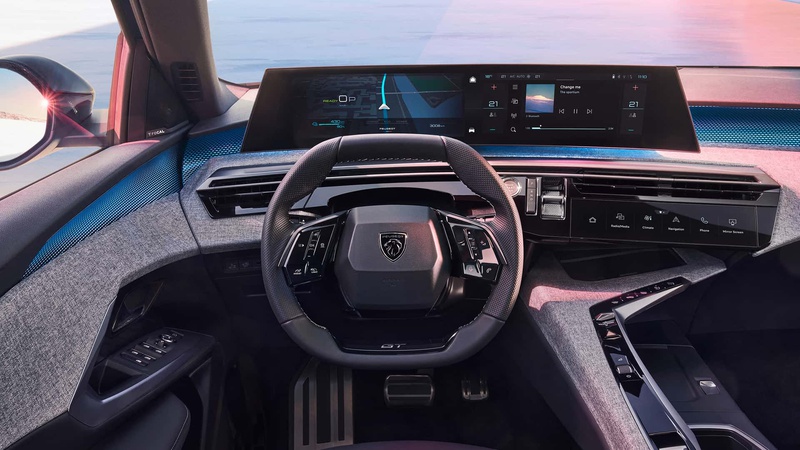
Peugeot E-3008
Below the central screen, on what would be called the center console in a conventional vehicle, are the so-called i-Toggles, fully customizable virtual and touch-sensitive buttons.
Seat heating is standard on all trim levels, and the front seats carry the AGR (Aktion fur Gesunder Ruecken) seal of approval from the German Association of Physicians and Therapists, which promotes research and prevention of back pain. As an option, the front seats can also be equipped with ventilation, a massage function and adaptive side bolsters that inflate or deflate according to the size of the occupant.
Luggage compartment
The Peugeot E-3008 has a boot capacity of 470 liters in the all-wheel drive version and 520 liters in the front-wheel drive version, and there are a total of 17 different storage compartments scattered throughout the interior that add up to 34 liters.
Trims
The new Peugeot E-3008 will be offered in two trim levels – Allure and GT – with three option packages and three electric powertrain choices.
E-3008 Allure models feature a single-tone paint finish and half leather-effect - half fabric upholstery with embossed motifs. The main standard equipment includes keyless entry and ignition, rear HD camera, rear parking sensors, LED headlamps and lights, 19-inch alloy wheels, Peugeot i-Cockpit with two 10-inch digital panels and i-Connect information system.
The E-3008 GT comes in two-tone paint with a black roof and Alcantara upholstery. Main standard equipment, in addition to that of the Allure version: 20-inch alloy wheels, Pixel LED headlamps, front parking sensors, motorised tailgate, heated front seats and steering wheel, induction smartphone charger, customisable ambient lighting, Panoramic i-Cockpit with curved 21-inch screen, customisable i-Toggles, i-Connect Advanced connected information system.
Powertrain Options
The first powertrain consists of a 400-volt nickel-manganese-cobalt (NMC) 73-kilowatt-hour (net) battery pack and a front-mounted permanent magnet synchronous electric motor that produces 210 horsepower (157 kilowatts) and 343 Nm (253 pound-feet) of torque for an estimated range of 525 km (326 miles) on a full charge.
Next is a dual-motor version that uses the same 73 kWh battery and front motor as the previous variant, but adds a 111 hp (83 kW) / 166 Nm (122 lb-ft) electric motor to the rear axle for a combined output of 320 hp (240 kW). Estimated range for this version is also 525 km (326 miles), the same as the single-motor variant, meaning the rear motor could benefit from a disconnect system in certain driving conditions.
Finally, there's a long-range version with a larger 98 kWh (net) battery pack and a front-mounted electric motor that produces 230 hp (170 kW) and 343 Nm (253 lb-ft) of torque for a maximum range of 700 km (435 miles) on a full charge. There is no dual-motor option for this battery size.
| New E-3008 Electric 210 | New E-3008 Electric 320 Dual Motor AWD | New E-3008 Electric 230 Long Range | |
|---|---|---|---|
| Motor | Electric | Electric | Electric |
| Electric motor technology | Front / Rear Synchronous with permanent magnet / - | Front / Rear Synchronous with permanent magnet / Synchronous with permanent magnet | Synchronous with permanent magnet / - |
| Maximum power in kW (or hp) | 157 (210) from 4370 to 14000 rpm | 240 (320) cumulated: 157 (210) front from 4370 to 14000 rpm/ 83 (110) rear from 4760 to 14000 rpm | 170 (230) from 4740 to 14000 rpm |
| Maximum torque (Nm) | 343 from 250 à 4370 rpm | Front: 343 from 250 to 4370 rpm Rear: 166 from 0 to 4760 rpm | 343 from 250 to 4740 rpm |
| TRANSMISSION | Type: single-speed gearbox | Type: single-speed gearbox | Type: single-speed gearbox |
| Ratio Front / Rear | 9,77 / - | 9,77 / 12,396 | 9,77 / - |
| BATTERY | Technology: Lithium-ion NMC | Technology: Lithium-ion NMC | Technology: Lithium-ion NMC |
| Number of modules/cellules | 11/96 | NA | NA |
| Useful Capacity (kWh) | 73 | 73 | 98 |
| Weight (kg) | 520 | 520 | 574 |
| Voltage(V) | 400 | 400 | 400 |
| Masses | Kerb weight (kg): 2114 | Kerb weight (kg): 2199 | Kerb weight (kg): 2174 |
| Maximum braked trailer weight - 12% slope (kg) | 1250 | 1350 | 1200 |
| Perfomance | Maximum speed (km/h): 170 | Maximum speed (km/h): 180 | Maximum speed (km/h): 170 |
| 1,000 m standing start | 29,7 | 27,2 | 29,8 |
| 400 m standing start | 16,5 | 14,7 | 16,6 |
| 0 to 100 km/h | 8,7 | 6,4 | 8,9 |
| In-gear acceleration (seconds) - 30 to 60 km/h | 2,3 | 1,5 | 2,3 |
| In-gear acceleration (seconds) - 60 to 90 km/h | 2,8 | 2,3 | 2,8 |
| In-gear acceleration (seconds) - 80 to 120 km/h | 5,3 | 3,9 | 5,4 |
| Range & Consumption | Range in WLTP combined (km): 525 | Range in WLTP combined (km): 525 | Range in WLTP combined (km): 700 |
Several driving modes are available to the driver, including a 4WD mode on the dual-motor variant that distributes power to all four wheels when the road surface is slippery, but only at speeds up to 83 miles per hour (135 kilometers per hour).
Charging
The Electric 3008's charging port is located on the rear left fender and allows users to recharge the battery using either AC or DC power. For AC charging, the standard on-board charger can accept up to 11 kW from a three-phase source, with an optional 22 kW three-phase unit available.
On the DC side, the new E-3008 can accept up to 160 kW from a compatible stall, allowing the standard battery to be recharged from 20 percent state of charge (SoC) to 80 percent in 30 minutes, and in less than 30 minutes for the extended-range variant.
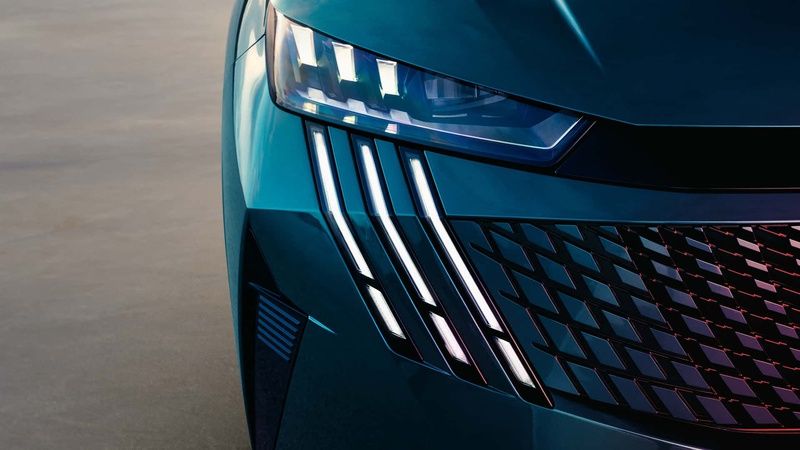


Peugeot E-3008
The first STLA Medium-based EV also benefits from vehicle-to-load (V2L) functionality, which allows users to export power from the high-voltage battery via the charging plug for household appliances or other uses at up to 3 kW and 16 amps (A).
In addition, the compact crossover features V1G smart charging, which integrates the EV with the owner's home energy provider to automatically regulate charging time and power consumption according to time slots to keep charging costs as low as possible.
Heat Pump
The all-electric Peugeot 3008 comes standard with a heat pump instead of conventional interior heating to make the most of the available battery capacity. It also offers three levels of regenerative braking, which can be selected using the steering wheel-mounted paddles: Low, for an effect similar to that of an internal combustion engine vehicle, Moderate and Increased.
The last two modes automatically turn on the rear brake lights, Peugeot says, and the driver can use the left paddle to increase the level of regeneration, while the right paddle is for decreasing regenerative braking. However, the French automaker doesn't mention anything about single-pedal driving.
Thermal management of the battery uses circulating coolant to ensure fast charging, optimised range and longer life. The battery is guaranteed for 8 years (or 160,000 km) at 70% of its charge capacity.
Semi-autonomous driving capabilities
The Drive Assist Plus system available on the new E-3008, assists the driver by using all the car's sensors (cameras, radar, etc.) and information from the connected navigation system. These assistance systems are designed to lighten the driver's workload on multi-lane roads such as motorways or dual carriageways:
- Adaptive cruise control with Stop & Go function and lane-keeping assist. Manages the steering and speed of the new E-3008 to keep it in a lane and at a speed preset by the driver.
- Semi-automatic lane change. Changes lane for the driver when required. Simply activate the indicator and press the "ok" button on the steering wheel, and the system will steer you towards the new lane.
- Early speed recommendation. Detects any change in the speed limit by reading road signs and gathering information from the connected navigation system and suggests that the driver adjust the Adaptive Cruise Control setting. If it detects rain, the system immediately suggests reducing speed in accordance with the speed limit, for example from 130 to 110km/h on the motorway.
Production and pricing
The Peugeot E-3008 crossover will be built at the Stellantis plant in Sochaux, France, where the battery packs will also be assembled, with deliveries to begin in Europe and other markets by the end of the year.
Pricing is expected to be higher than that of the current Peugeot 3008, which was offered in mild hybrid and plug-in hybrid forms but never had an EV version. The automaker has pledged to offer electric options across its entire model range by 2025, before transitioning to an EV-only brand in Europe by 2030.
Source: Peugeot
.jpg)
